Sustainable Ketalization of Glycerol with Ethyl Levulinate Catalyzed by the Iron(III)-Based Metal-Organic Framework MIL-88A
Abstract
1. Introduction
2. Results and Discussion
2.1. Catalyst Synthesis and Characterization
2.2. Catalyst Optimization and Recycling
3. Materials and Method
3.1. Materials
3.2. Catalyst Preparation
3.3. Catalysts Activity and Reuse Tests
3.4. Yield Calculation
3.5. Iron Content Measurement
4. Conclusions
Supplementary Materials
Author Contributions
Funding
Data Availability Statement
Acknowledgments
Conflicts of Interest
Sample Availability
Abbreviations
| 1H-NMR | Proton nuclear magnetic resonance |
| MOF | Metal–organic framework |
| XRD | X-ray diffraction pattern |
| SEM | Scanning electronic microscopy |
| TGA | Thermogravimetric analysis |
| NMR | Nuclear magnetic resonance |
| R2 | Adjusted residual sum of squares |
References
- Bagheri, N.; Khataee, A.; Habibi, B.; Hassanzadeh, J. Mimetic Ag nanoparticle/Zn-based MOF nanocomposite (AgNPs@ZnMOF) capped with molecularly imprinted polymer for the selective detection of patulin. Talanta 2018, 179, 710–718. [Google Scholar] [CrossRef]
- Jalili, R.; Khataee, A.; Rashidi, M.-R.; Luque, R. Dual-colored carbon dot encapsulated metal-organic framework for ratiometric detection of glutathione. Sens. Actuators B Chem. 2019, 297, 126775. [Google Scholar] [CrossRef]
- Russo, V.; Hmoudah, M.; Broccoli, F.; Iesce, M.R.; Jung, O.-S.; Di Serio, M. Applications of Metal Organic Frameworks in Wastewater Treatment: A Review on Adsorption and Photodegradation. Front. Chem. Eng. 2020, 2, 581487. [Google Scholar] [CrossRef]
- Mullen, B.D.; Badarinarayana, V.; Santos-Martinez, M.; Selifonov, S. Catalytic Selectivity of Ketalization Versus Transesterification. Top. Catal. 2010, 53, 1235–1240. [Google Scholar] [CrossRef]
- Keijer, T.; Bakker, V.; Slootweg, J.C. Circular chemistry to enable a circular economy. Nat. Chem. 2019, 11, 190–195. [Google Scholar] [CrossRef] [PubMed]
- Jessop, P.G. The use of auxiliary substances (e.g., solvents, separation agents) should be made unnecessary wherever possible and innocuous when used. Green Chem. 2016, 18, 2577–2578. [Google Scholar] [CrossRef]
- Peters, M.; von der Assen, N. It is better to prevent waste than to treat or clean up waste after it is formed—Or: What Benjamin Franklin has to do with “Green Chemistry”. Green Chem. 2016, 18, 1172–1174. [Google Scholar] [CrossRef]
- Sheldon, R.A. Green chemistry and resource efficiency: Towards a green economy. Green Chem. 2016, 18, 3180–3183. [Google Scholar] [CrossRef]
- Checa, M.; Nogales-Delgado, S.; Montes, V.; Encinar, J.M. Recent Advances in Glycerol Catalytic Valorization: A Review. Catalysts 2020, 10, 1279. [Google Scholar] [CrossRef]
- Kaur, J.; Sarma, A.K.; Jha, M.K.; Gera, P. Valorisation of crude glycerol to value-added products: Perspectives of process technology, economics and environmental issues. Biotechnol. Rep. 2020, 27, e00487. [Google Scholar] [CrossRef]
- Hossain, M.A.; Mohamed Iqbal, M.A.; Julkapli, N.M.; San Kong, P.; Ching, J.J.; Lee, H.V. Development of catalyst complexes for upgrading biomass into ester-based biolubricants for automotive applications: A review. RSC Adv. 2018, 8, 5559–5577. [Google Scholar] [CrossRef] [PubMed]
- Benessere, V.; Cucciolito, M.E.; De Santis, A.; Di Serio, M.; Esposito, R.; Melchiorre, M.; Nugnes, F.; Paduano, L.; Ruffo, F. A Sustainable Process for the Production of Varnishes Based on Pelargonic Acid Esters. J. Am. Oil Chem. Soc. 2019, 96, 443–451. [Google Scholar] [CrossRef]
- Manzer, L.E. Preparation of Levulinic Acid Esters from A-Angelica Lactone and Alcohols. WO2005097723A2, 10 November 2005. [Google Scholar]
- Kuo, T.; Hall, D.A. Waterborne Coating Compositions Containing low-Voc Coalescents. WO2012054314A1, 26 April 2012. [Google Scholar]
- Badgujar, K.C.; Bhanage, B.M. The green metric evaluation and synthesis of diesel-blend compounds from biomass derived levulinic acid in supercritical carbon dioxide. Biomass Bioenergy 2016, 84, 12–21. [Google Scholar] [CrossRef]
- Shrivastav, G.; Khan, T.S.; Agarwal, M.; Haider, M.A. Reformulation of Gasoline To Replace Aromatics by Biomass-Derived Alkyl Levulinates. ACS Sustain. Chem. Eng. 2017, 5, 7118–7127. [Google Scholar] [CrossRef]
- Behler, A.; Pottie, L.; Max, E.; Giesinger, J.; Grumelard, J. Solubilizing Agents for UV Filters in Cosmetic Formulations. WO2018007577A1 11 January 2018. [Google Scholar]
- Coats, J.R.; Norris, E.J.; Klimavicz, J.S. Solubilizing Agents for UV Filters in Cosmetic Formulations. WO2018039376A1, 11 January 2018. [Google Scholar]
- Özeren, H.D.; Balçık, M.; Ahunbay, M.G.; Elliott, J.R. In Silico Screening of Green Plasticizers for Poly(vinyl chloride). Macromolecules 2019, 52, 2421–2430. [Google Scholar] [CrossRef]
- Samoilov, V.O.; Ramazanov, D.N.; Nekhaev, A.I.; Maximov, A.L.; Bagdasarov, L.N. Heterogeneous catalytic conversion of glycerol to oxygenated fuel additives. Fuel 2016, 172, 310–319. [Google Scholar] [CrossRef]
- Mota, C.J.A.; da Silva, C.X.A.; Rosenbach, N.; Costa, J.; da Silva, F. Glycerin Derivatives as Fuel Additives: The Addition of Glycerol/Acetone Ketal (Solketal) in Gasolines. Energy Fuels 2010, 24, 2733–2736. [Google Scholar] [CrossRef]
- Alptekin, E.; Canakci, M. Performance and emission characteristics of solketal-gasoline fuel blend in a vehicle with spark ignition engine. Appl. Therm. Eng. 2017, 124, 504–509. [Google Scholar] [CrossRef]
- Grigoletto, F.; Martins, S.; Mariussi, J.R.; Silva, S. Polish Removal Formulations. WO2017122037A1, 20 July 2017. [Google Scholar]
- Chino, M.; Leone, L.; Zambrano, G.; Pirro, F.; D’Alonzo, D.; Firpo, V.; Aref, D.; Lista, L.; Maglio, O.; Nastri, F.; et al. Oxidation catalysis by iron and manganese porphyrins within enzyme-like cages. Biopolymers 2018, 109, e23107. [Google Scholar] [CrossRef]
- Melchiorre, M.; Benessere, V.; Cucciolito, M.E.; Melchiorre, C.; Ruffo, F.; Esposito, R. Direct and Solvent-Free Oxidative Cleavage of Double Bonds in High-Oleic Vegetable Oils. ChemistrySelect 2020, 5, 1396–1400. [Google Scholar] [CrossRef]
- Esposito, R.; Melchiorre, M.; Annunziata, A.; Cucciolito, M.E.; Ruffo, F. Emerging catalysis in biomass valorisation: Simple Zn(II) catalysts for fatty acids esterification and transesterification. ChemCatChem 2020, 12, 5858–5879. [Google Scholar] [CrossRef]
- Melchiorre, M.; Cucciolito, M.E.; Di Serio, M.; Ruffo, F.; Tarallo, O.; Trifuoggi, M.; Esposito, R. Homogeneous Catalysis and Heterogeneous Recycling: A Simple Zn(II) Catalyst for Green Fatty Acid Esterification. ACS Sustain. Chem. Eng. 2021, 9, 6001–6011. [Google Scholar] [CrossRef] [PubMed]
- Melchiorre, M.; Amendola, R.; Benessere, V.; Cucciolito, M.E.; Ruffo, F.; Esposito, R. Solvent-free transesterification of methyl levulinate and esterification of levulinic acid catalyzed by a homogeneous iron(III) dimer complex. Mol. Catal. 2020, 483, 110777. [Google Scholar] [CrossRef]
- Esposito, R.; Cucciolito, M.E.; D’Amora, A.; Di Guida, R.; Montagnaro, F.; Ruffo, F. Highly efficient iron(III) molecular catalysts for solketal production. Fuel Process. Technol. 2017, 167, 670–673. [Google Scholar] [CrossRef]
- Esposito, R.; Raucci, U.; Cucciolito, M.E.; Di Guida, R.; Scamardella, C.; Rega, N.; Ruffo, F. Iron(III) Complexes for Highly Efficient and Sustainable Ketalization of Glycerol: A Combined Experimental and Theoretical Study. ACS Omega 2019, 4, 688–698. [Google Scholar] [CrossRef]
- Taddeo, F.; Esposito, R.; Russo, V.; Di Serio, M. Kinetic Modeling of Solketal Synthesis from Glycerol and Acetone Catalyzed by an Iron(III) Complex. Catalysts 2021, 11, 83. [Google Scholar] [CrossRef]
- Konwar, L.J.; Samikannu, A.; Mäki-Arvela, P.; Boström, D.; Mikkola, J.-P. Lignosulfonate-based macro/mesoporous solid protonic acids for acetalization of glycerol to bio-additives. Appl. Catal. B 2018, 220, 314–323. [Google Scholar] [CrossRef]
- Poly, S.S.; Jamil, M.A.R.; Touchy, A.S.; Yasumura, S.; Siddiki, S.M.A.H.; Toyao, T.; Maeno, Z.; Shimizu, K.-i. Acetalization of glycerol with ketones and aldehydes catalyzed by high silica Hβ zeolite. Mol. Catal. 2019, 479, 110608. [Google Scholar] [CrossRef]
- Li, P.; Xiao, Z.; Chang, C.; Zhao, S.; Xu, G. Efficient Synthesis of Biobased Glycerol Levulinate Ketal and Its Application for Rigid Polyurethane Foam Production. Ind. Eng. Chem. Res. 2020, 59, 17520–17528. [Google Scholar] [CrossRef]
- Selifonov, S.; Rothstein, S.D.; Mullen, B.D. Method of Making Ketals and Acetals. WO-2009048874-A1 16 April 2009. [Google Scholar]
- Selifonov, S.; Mullen, B.D.; Wicks, D.A.; Badarinarayana, V. Ketal Ester Derivatives. US20110223365A1, 15 September 2011. [Google Scholar]
- Chalati, T.; Horcajada, P.; Gref, R.; Couvreur, P.; Serre, C. Optimisation of the synthesis of MOF nanoparticles made of flexible porous iron fumarate MIL-88A. J. Mater. Chem. 2011, 21, 2220–2227. [Google Scholar] [CrossRef]
- Wang, L.; Zhang, Y.; Li, X.; Xie, Y.; He, J.; Yu, J.; Song, Y. The MIL-88A-Derived Fe3O4-Carbon Hierarchical Nanocomposites for Electrochemical Sensing. Sci. Rep. 2015, 5, 14341. [Google Scholar] [CrossRef] [PubMed]
- Andrew Lin, K.-Y.; Chang, H.-A.; Hsu, C.-J. Iron-based metal organic framework, MIL-88A, as a heterogeneous persulfate catalyst for decolorization of Rhodamine B in water. RSC Adv. 2015, 5, 32520–32530. [Google Scholar] [CrossRef]
- Wang, J.; Wan, J.; Ma, Y.; Wang, Y.; Pu, M.; Guan, Z. Metal–organic frameworks MIL-88A with suitable synthesis conditions and optimal dosage for effective catalytic degradation of Orange G through persulfate activation. RSC Adv. 2016, 6, 112502–112511. [Google Scholar] [CrossRef]
- Liu, N.; Huang, W.; Zhang, X.; Tang, L.; Wang, L.; Wang, Y.; Wu, M. Ultrathin graphene oxide encapsulated in uniform MIL-88A(Fe) for enhanced visible light-driven photodegradation of RhB. Appl. Catal. B 2018, 221, 119–128. [Google Scholar] [CrossRef]
- Serre, C.; Mellot-Draznieks, C.; Surblé, S.; Audebrand, N.; Filinchuk, Y.; Férey, G. Role of Solvent-Host Interactions That Lead to Very Large Swelling of Hybrid Frameworks. Science 2007, 315, 1828–1831. [Google Scholar] [CrossRef] [PubMed]
- Santos-Vieira, I.C.M.S.; Mendes, R.F.; Almeida Paz, F.A.; Rocha, J.; Simões, M.M.Q. Solketal Production via Solvent-Free Acetalization of Glycerol over Triphosphonic-Lanthanide Coordination Polymers. Catalysts 2021, 11, 598. [Google Scholar] [CrossRef]
- Cheng, Y.; Kondo, A.; Noguchi, H.; Kajiro, H.; Urita, K.; Ohba, T.; Kaneko, K.; Kanoh, H. Reversible Structural Change of Cu-MOF on Exposure to Water and Its CO2 Adsorptivity. Langmuir 2009, 25, 4510–4513. [Google Scholar] [CrossRef]


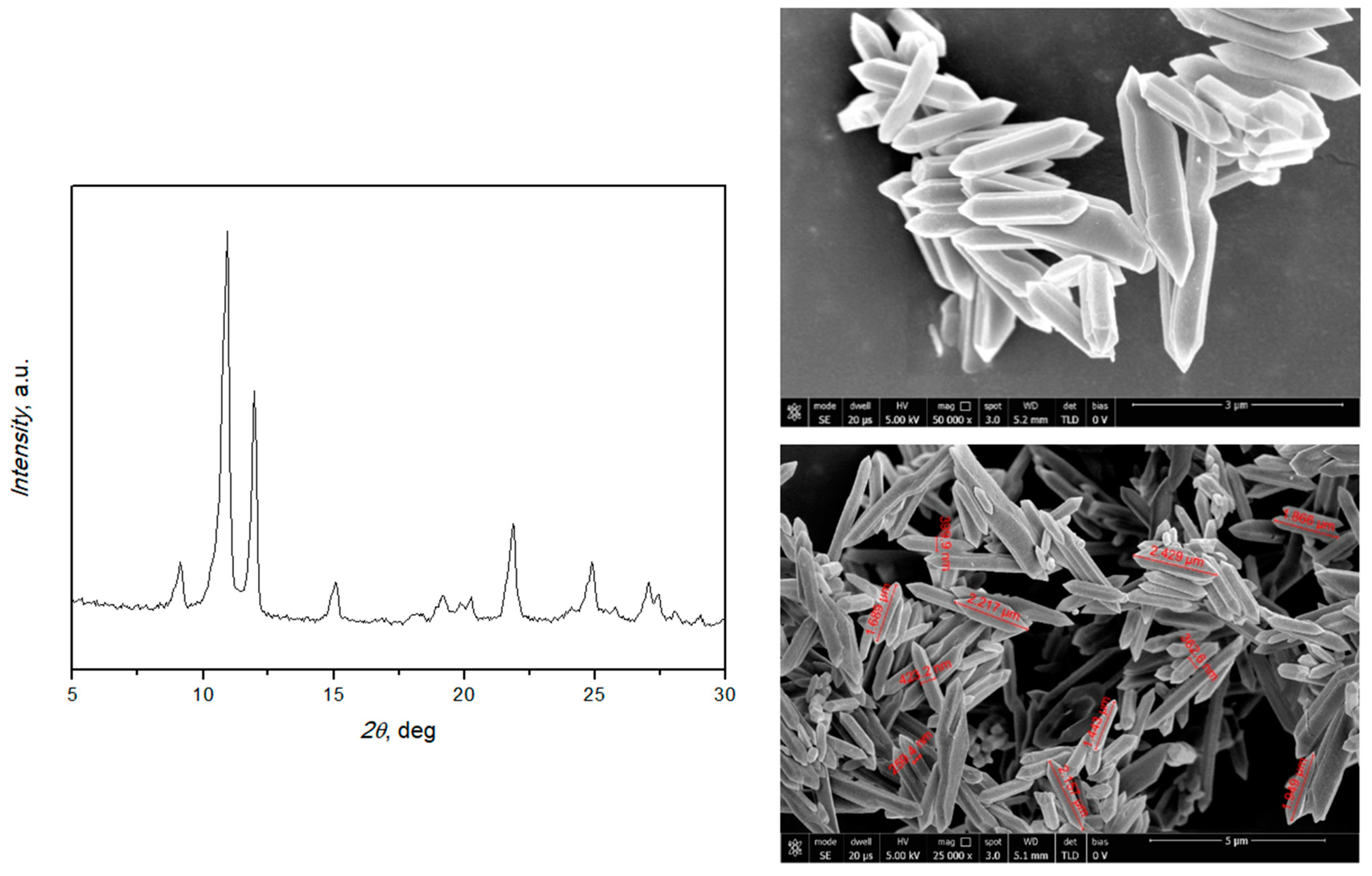
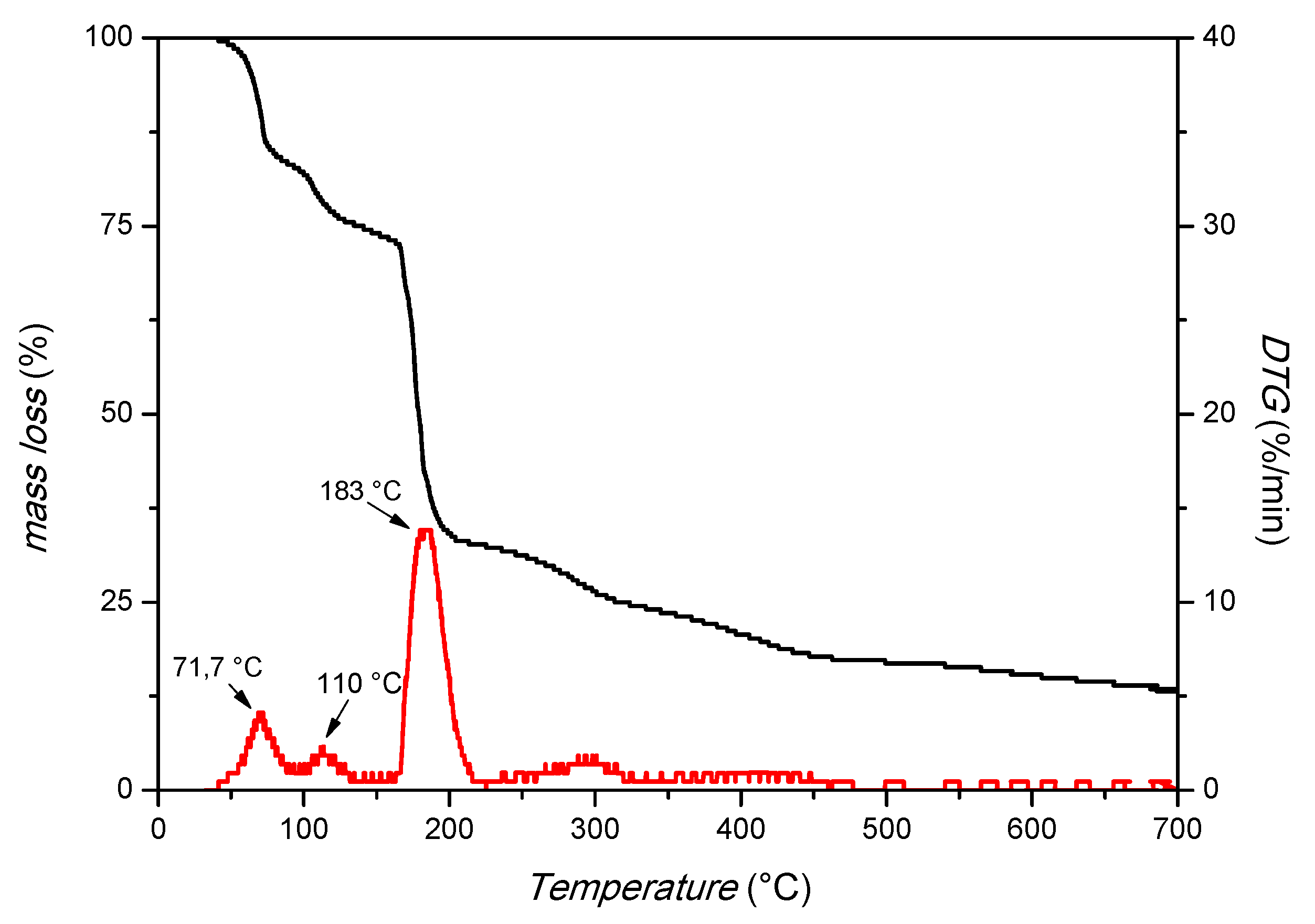
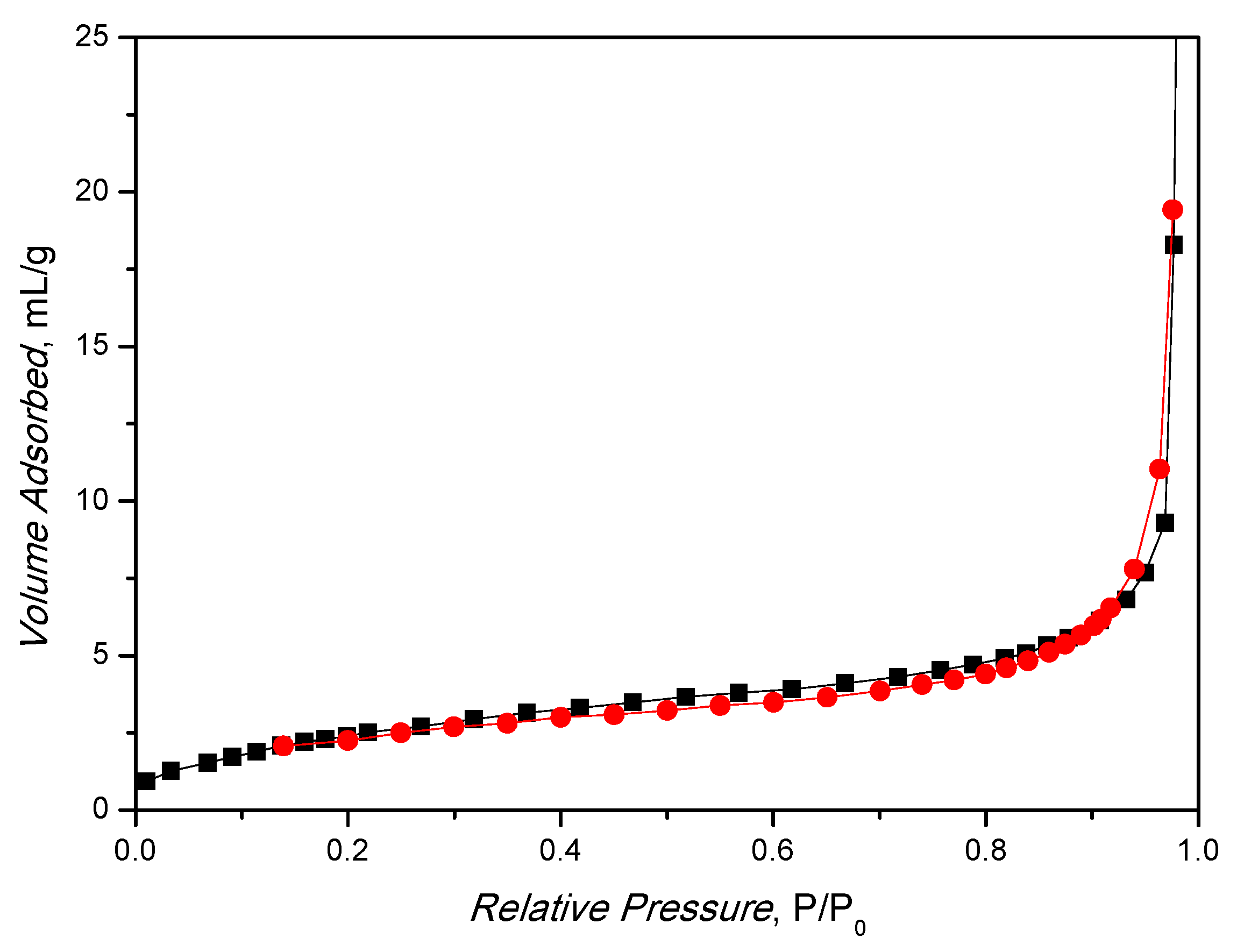
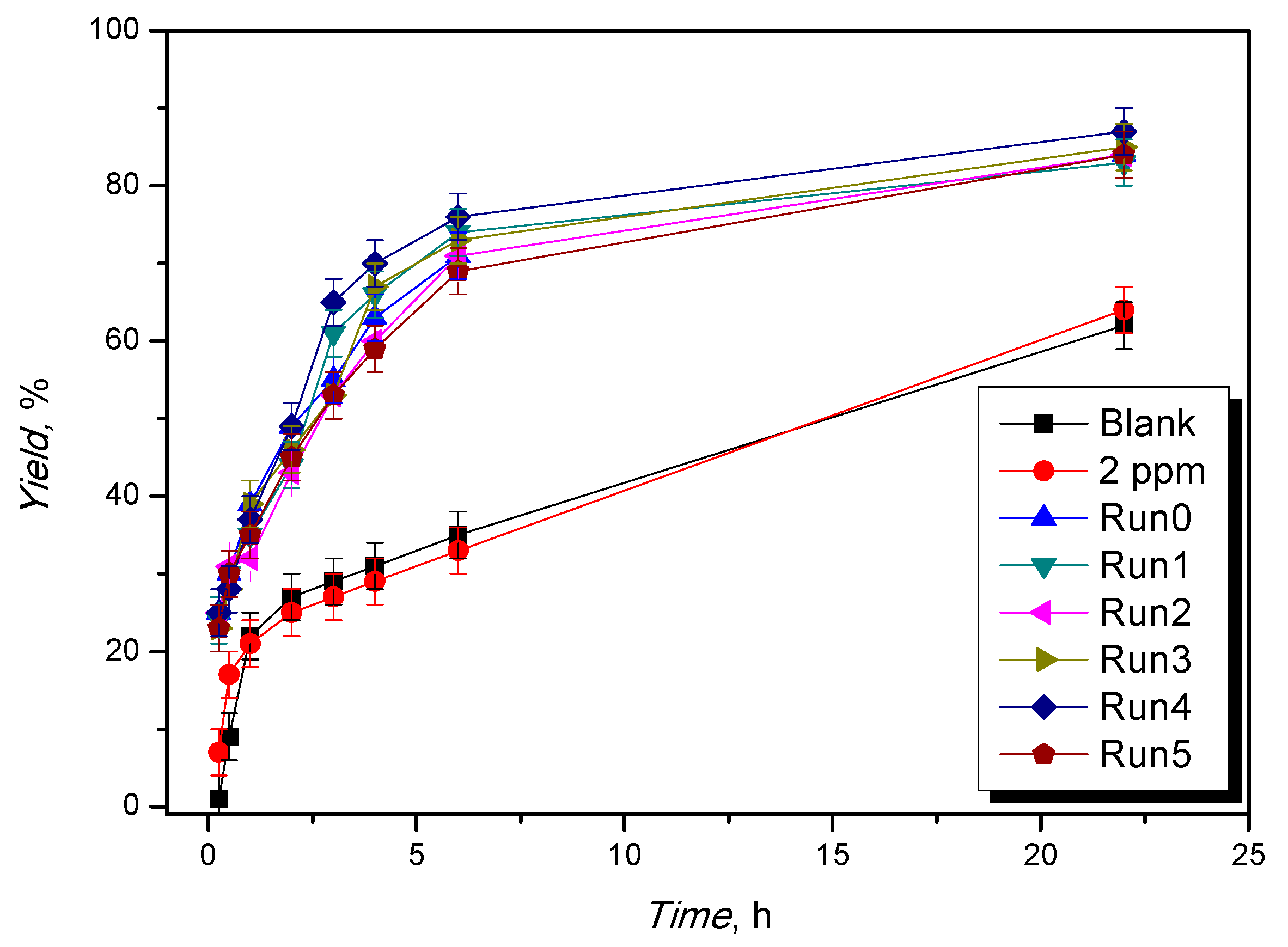
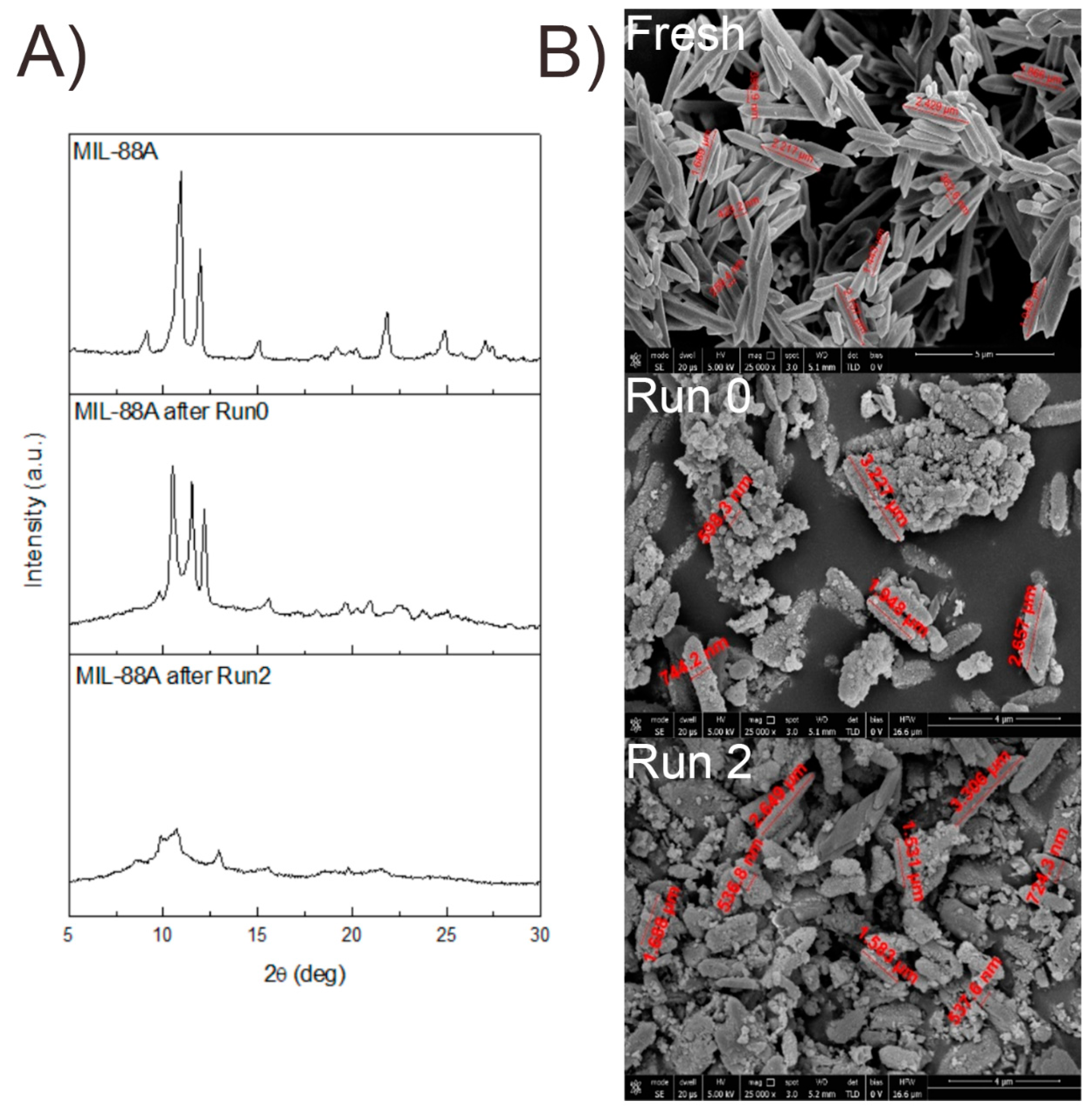
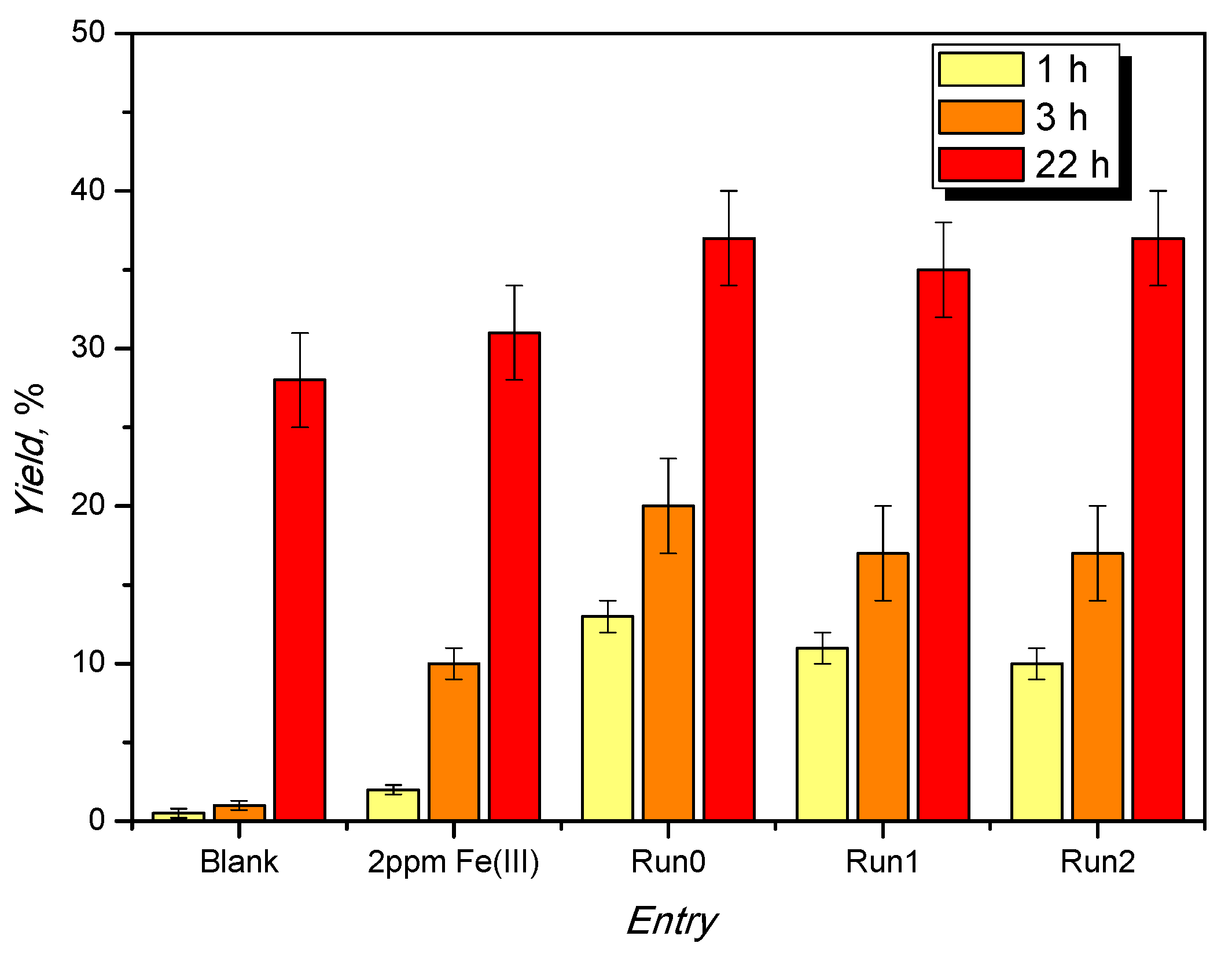
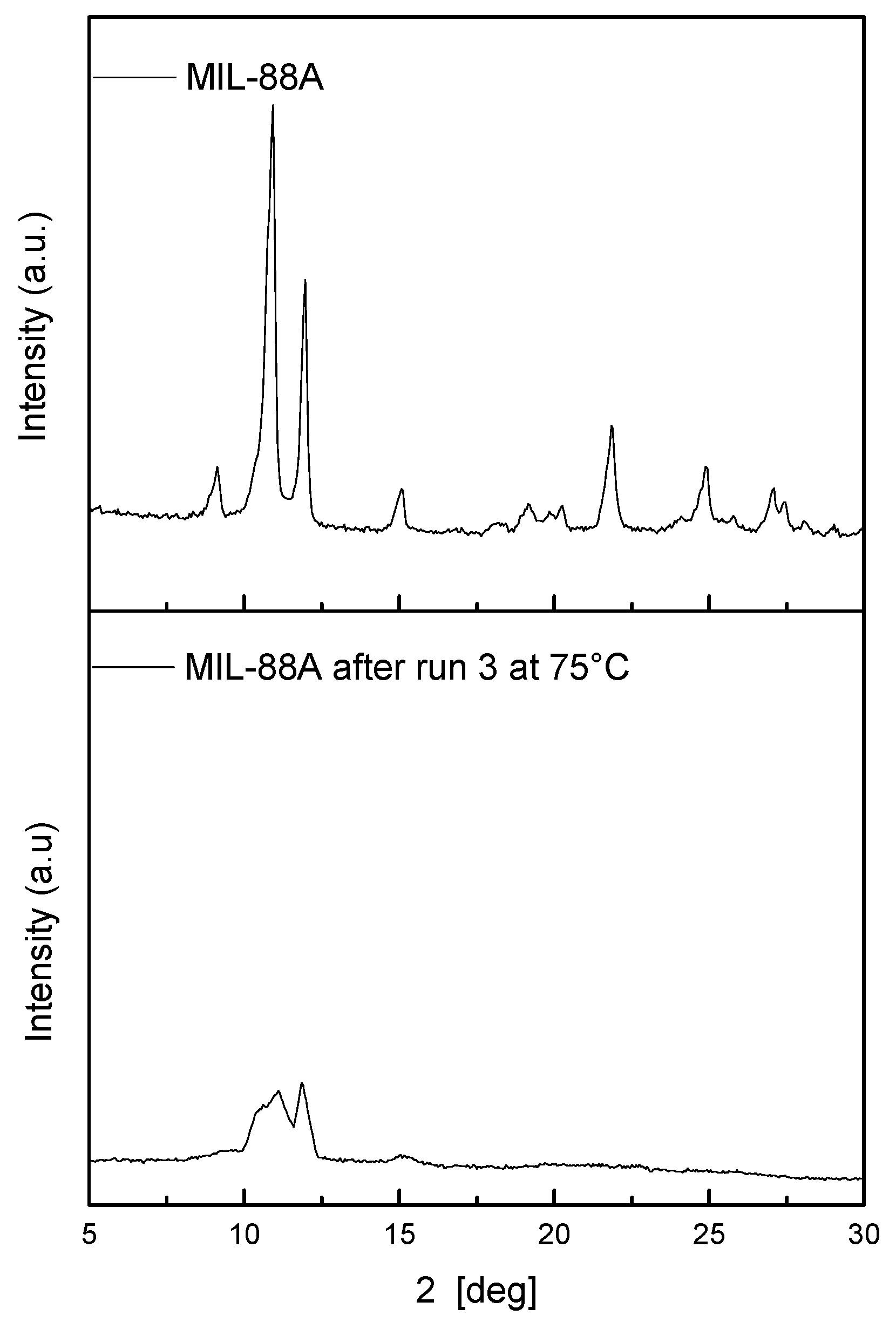

| Ketone | Catalyst | Conditions | Ketone:Glycerol Molar Ratio | Yield (%) | Ref. |
|---|---|---|---|---|---|
| Methyl levulinate | Lignosulfonate-based macro/mesoporous solid protonic acids, 0.5 wt% | 1 h, 100 °C, water removal: 50 mL/min N2 flow | 4:1 | 100 a | [32] |
| Methyl levulinate | High silica Hβ zeolite, ca. 3 wt% respect to glycerol | 20 h, N2 atmosphere, water removal: toluene reflux | 1.5:1 | 81 | [33] |
| Methyl levulinate | Homogeneous: iminopyridine iron(III) complex, 0.5% mol respect to glycerol | 1.5 h, 110 °C, 36 mmHg (48 mbar), water removal: vacuum and 3 Å molecular sieves | 4:1 | >99 | [30] |
| Methyl levulinate | Homogeneous: H2SO4, ca. 0.2% mol with respect to glycerol | 0.5 h, 123 °C, vacuum degree: −90 kPa (ca. 110 mbar), water removal: vacuum and temperature | 4.4:1 | 97.2 | [34] |
| Ethyl levulinate | Homogeneous: H2SO4, ca. 0.02% mol with respect to glycerol | 0.33 h, 110 °C, N2 atmosphere, 25–30 mmHg (33–40 mbar), water removal: vacuum and temperature | 3.8:1 | >99 | [4] |
| Catalyst Reuses | Yield at 1 h a | Yield at 6 h a | Yield at 22 h a |
|---|---|---|---|
| Blank | 22% | 55% | 64% |
| Run 0 | 39% | 71% | 84% |
| Run 1 | 35% | 74% | 83% |
| Run 2 | 32% | 71% | 84% |
| Catalyst Reuses | Yield at 6 h a |
|---|---|
| Blank | 55% |
| Run 0 | 61% |
| Run 1 | 64% |
| Run 2 | 67% |
| Catalyst Reuses | Yield at 6 h a |
|---|---|
| Run 0 | 76% |
| Run 1 | 77% |
| Run 2 | 76% |
Publisher’s Note: MDPI stays neutral with regard to jurisdictional claims in published maps and institutional affiliations. |
© 2022 by the authors. Licensee MDPI, Basel, Switzerland. This article is an open access article distributed under the terms and conditions of the Creative Commons Attribution (CC BY) license (https://creativecommons.org/licenses/by/4.0/).
Share and Cite
Melchiorre, M.; Lentini, D.; Cucciolito, M.E.; Taddeo, F.; Hmoudah, M.; Di Serio, M.; Ruffo, F.; Russo, V.; Esposito, R. Sustainable Ketalization of Glycerol with Ethyl Levulinate Catalyzed by the Iron(III)-Based Metal-Organic Framework MIL-88A. Molecules 2022, 27, 7229. https://doi.org/10.3390/molecules27217229
Melchiorre M, Lentini D, Cucciolito ME, Taddeo F, Hmoudah M, Di Serio M, Ruffo F, Russo V, Esposito R. Sustainable Ketalization of Glycerol with Ethyl Levulinate Catalyzed by the Iron(III)-Based Metal-Organic Framework MIL-88A. Molecules. 2022; 27(21):7229. https://doi.org/10.3390/molecules27217229
Chicago/Turabian StyleMelchiorre, Massimo, Domenico Lentini, Maria Elena Cucciolito, Francesco Taddeo, Maryam Hmoudah, Martino Di Serio, Francesco Ruffo, Vincenzo Russo, and Roberto Esposito. 2022. "Sustainable Ketalization of Glycerol with Ethyl Levulinate Catalyzed by the Iron(III)-Based Metal-Organic Framework MIL-88A" Molecules 27, no. 21: 7229. https://doi.org/10.3390/molecules27217229
APA StyleMelchiorre, M., Lentini, D., Cucciolito, M. E., Taddeo, F., Hmoudah, M., Di Serio, M., Ruffo, F., Russo, V., & Esposito, R. (2022). Sustainable Ketalization of Glycerol with Ethyl Levulinate Catalyzed by the Iron(III)-Based Metal-Organic Framework MIL-88A. Molecules, 27(21), 7229. https://doi.org/10.3390/molecules27217229











